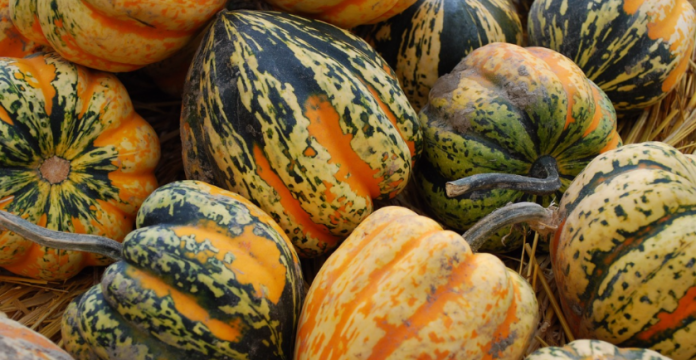
Now is the time to explore the delightful selection of winter squash, and acorn squash (Cucurbita pepo; aka pepper squash) should definitely be on your list. Named for its resemblance to a large acorn, this vegetable has orange-yellow flesh and dark green, tan, orange, or yellow skin. Acorn squash are indigenous to North and Central America and was first introduced to the early Europeans by the Native Americans.
It's a nutritional powerhouse
Winter squash in general are more nutritious than summer squash. One cup of cubed baked acorn squash contains 115 calories and more than 10 percent Daily Value (%DV) of the following nutrients:
11%DV iron, necessary for the production of red blood cells and hemoglobin and for metabolizing proteins
18%DV vitamin A, important for vision, healthy bones and skin, immune system integrity, and cell growth
20%DV vitamin B6, needed for a healthy nervous system and adrenal function
22%DV magnesium, regulates potassium levels, involved in energy metabolism, strengthens bones, helps maintain healthy blood pressure
23%DV thiamine, a B vitamin that plays a vital role in nervous system and cardiovascular functioning
25%DV manganese, a mineral that is essential for building bone and bone metabolism
26%DV potassium, necessary for muscle contractions and maintaining water balance
36%DV fiber, most of which is soluble fiber, which helps lower cholesterol and regulate glucose levels; also helps maintain a healthy intestinal tract
37%DV vitamin C, a potent antioxidant that is involved in collagen production, immune function, and more
Choosing and storing acorn squash
When shopping for acorn squash, choose a vegetable that is heavy and dull for its size. Avoid any squash that have soft spots. At home, store the squash in a cool, dry area away from sunlight.
You can keep an acorn squash for up to three months…but don’t wait that long to enjoy it! You can always freeze the squash. Simply cook it, remove the skin, cut it into large chunks, and place in a freezer safe container.
Ideally, however, use the vegetable within three to four days of purchase, especially if you want to optimize the vitamin C content. Don’t cut the squash until you are ready to prepare it and then bake or steam it rather than boil it. Boiling destroys much of the vitamin C.
One question about acorn squash is whether you can eat the skin. Some acorn squash have thin skin, which is soft and tasty, but some of the veggies have a tougher skin. It’s a personal choice, but you’re encouraged to give it a try! (Note: buy organic acorn squash if you want to eat the skin.)
Acorn squash inspiration
Many acorn squash recipes involve stuffing the vegetable or making soup, so here’s something a little different. This is a variation on a recipe from Whole Food Life.
Acorn Squash Burgers
1 acorn squash
1 ½ cup rolled oats
½ cup diced onion
½ cup diced celery
1 cup crushed walnut pieces
¼ cup oat flour
1 serving commercial egg replacer or combine 1 tbsp flaxseed with 3 tbsp warm water, whisk well, and let stand for 1 minute
1 tsp dried coriander
1/8 tsp salt
¼ tsp black pepper
Olive oil
Preheat oven to 350F. Cut squash in half, remove the seeds, and brush the squash with olive oil. Place face down on a lined baking sheet and bake for 40 to 45 minutes, until a fork easily passes through the flesh.
Remove the skin and place the skinned squash in a colander for 20 minutes to allow any excess water to drip off. Once the squash has cooled, combine all the ingredients in a bowl. Use ¼ cup of the mixture to form each patty. Place the patties in a baking sheet and bake in the oven for 30 to 35 minutes. Flip them over after about 15 minutes. You can freeze any leftovers. Makes about 15 small patties or 10 larger ones.
References
Healthy Eating SF Gate. Healthy acorn squash
My Whole Food Life.com. Acorn squash veggie burgers
USDA. National Nutrient Database. Acorn squash










